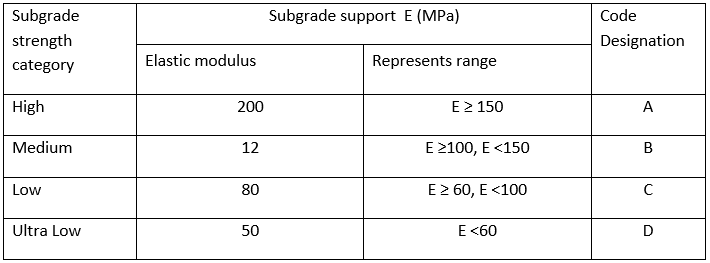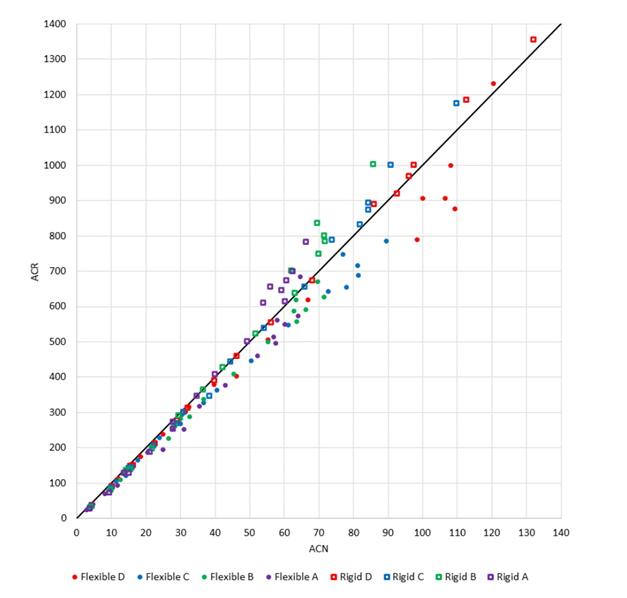Definition of ACR
ACR is a number that expresses the relative effect of an aircraft at a given configuration on a pavement structure for a specified standard subgrade strength. The aircraft manufacturer provides the official computation of an ACR value. For rigid and flexible pavements, the aircraft landing gear support requirements are determined by the layer elastic method (LEA) for each subgrade support category. An ACR is approximately 10 times that of an ACN.
ACRs are calculated using prescribed technical method of ICAO
Under the ACR-PCR system, each aircraft has assigned an ACR that indicates design thickness requirements for the aircraft on a more expanded scale that ranges from an ACR of 5 for light aircraft to an ACR of 1300 or more for heavy aircraft. ACR values are published for both flexible and rigid pavements and at four (4) subgrade categories that span the range of subgrade and bearing support values normally encountered. The ranges of subgrade strength covered by these standard subgrade categories (designated as A, B, C and D) are shown below.ACRs must be calculated using a prescribed technical method, which is clearly defined.
Determination of the ACR
Computation of the ACR requires detailed information on the operational characteristics of the aircraft, such as maximum aft center of gravity, maximum ramp weight, wheel spacing, and tire pressure.
Subgrade Category
The ACR-PCR method adopts four standard levels of subgrade strength for rigid and flexible pavements. These standard categories are used to represent a range of subgrade conditions as shown in the table below
Subgrade strength category for rigid and flexible pavements

Operational Frequency
Operational frequency is defined in terms of coverages that represent a full-load application on a point in the pavement Aircraft seldom travel in a perfectly straight path or along the exact same path. The path is modeled by a statistically normal distribution to account for aircraft wander. It may take several trips or passes along the pavement for a specific point on the pavement to receive a full-load application from the aircraft. It is easy to observe the number of passes an aircraft may make on a given pavement, but the number of coverages must be mathematically derived based upon an established pass-to-coverage ratio for each aircraft.
ACR Calculation
Using the parameters defined for each type of pavement section, a mathematically derived single wheel load is calculated to define the landing gear/pavement interaction. The derived single wheel load implies equal stress to the pavement structure and eliminates the need to specify pavement thickness for comparative purposes. This is achieved by equating the thickness derived for a given aircraft landing gear to the thickness derived for a single wheel load at a standard tire pressure of 1,5 MPa (218 psi). The ACR is defined as two times the derived single wheel load (expressed in hundreds of kilograms). Programs for calculating ACRs are available at specialist websites.
Variables Involved in Determination of ACR Values
Because aircraft can be operated at various weight and center of gravity combinations, ICAO adopted standard operating conditions for determining ACR values. Aircraft manufacturers publish maximum weight and center of gravity information in their Airplane Characteristics for Airport Planning (ACAP) manuals. The ACR is determined at the weight and center of gravity combination that creates the maximum ACR value. Tire pressures are assumed to be those recommended by the manufacturer for the noted conditions.
- To standardize the ACR calculation for flexible pavement the derived single wheel load is calculated at a constant pressure of 1.50 MPa (218 psi) relative to a total thickness t computed for 36,500 passes of the aircraft.
- To standardize the ACR calculation for rigid pavements, a standard stress is stipulated as σ = 2,75 MPa (399 psi). Note the working stress used for the design has no relationship to the standard stress used for pavement strength reporting.
Comparison of ACN and ACR values for various common aircraft

